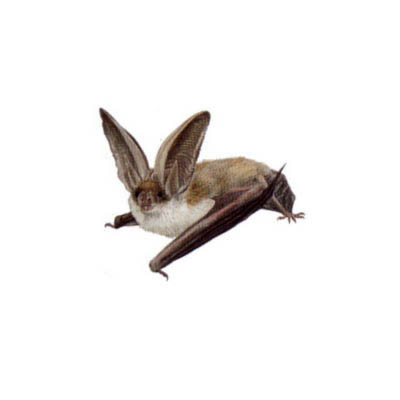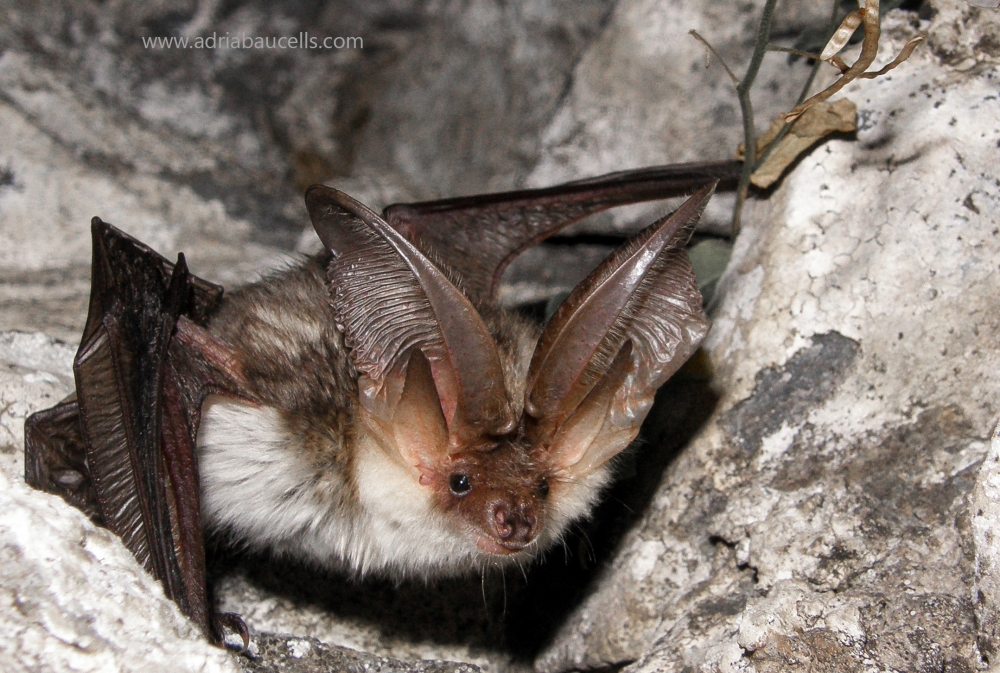Alpine long-eared bat

Plecotus macrobullaris Kuzjakin, 1965
Vespertilionidae
Least Concern
| Other names | |
|---|---|
| Catalan | Orellut alpí |
| Spanish | Orejudo alpino |
| English | Alpine long-eared bat |
| French | Oreillard montagnard |
| Basque | Belarrihandi alpetar |
| Galician | Orelludo alpino |
Description
Medium-sized bat, very similar to other species in the Plecotus genus, with a forearm length ranging from 37 to 46 mm and a weight between 6 and 10 g. The faces of older individuals are poorly pigmented, while young ones exhibit a distinctive dark, narrow, triangular structure on the lower part of the chin, which persists in adults. This dark protuberance allows for differentiation from other sympatric bat species. The wings are typically brown, although very pale in tone. The fur is characteristically dense and long, gray or brown on the back, with a grayish and usually almost white belly.
Fotografies
Distribution
It is distributed along the mountainous arc from the Pyrenees to the Caucasus, passing through the Taurus, Pindus, Dinaric Alps, and Alps. It is found in Andorra, France, Italy, Switzerland, Austria, Slovenia, Greece, Corsica, Turkey, Serbia, and from the Caucasus region to Iran and Syria. In the Pyrenees, it has been found in various locations along the axial line, with few known populations, all situated above 1,800 meters in altitude, typically associated with alpine meadows.
Roosts and phenology
In Europe, all summer roosts, both breeding and male colonies, occur in stone or metallic lofts and churches. In Armenia, colonies have been found in rock crevices. In recent decades, numerous individuals (mainly males) have been found sheltering among loose rocks in high mountain grasslands. Breeding roosts may be shared with other bat species like the brown (Plecotus auritus) or Balkan (Plecotus kolombatovici) long-eared bats. In Austria, pups are born in June in colonies of up to 30 females. In Tyrol, the average size of breeding colonies is 13 females.
There is limited data on the migration of this species, but some studies suggest long-distance movements between summer and winter roosts, with recorded displacements of up to 79 km. In winter, some individuals have been found in caves.
Habitat and diet
Most records are from high mountain habitats above 800 meters and up to 2,800 meters. However, in Slovenia and Istria (Croatia), colonies have been found at lower altitudes, between 300 and 660 meters. Throughout much of its distribution, though, it is always found above the tree line in alpine fields and meadows. While in Italy, it avoids coniferous forests, they may play a relevant role as hunting grounds. In Armenia, it is also found in mountain steppes without vegetation.
Its diet primarily consists of moths, although other insects such as flies and beetles are also hunted. It hunts in meadows, pastures, and steppes, typically capturing prey in the air, rarely picking it directly from the substrate.
Echolocation
Like other species in the same genus, it emits low-intensity calls composed of two distinct harmonics. The first harmonic has frequencies between 20 and 40 kHz, and the second between 30 and 60 kHz. As with all long-eared bats, it is included within the phonic group Plecotus sp..
Status
According to the IUCN Red List, it is considered Least Concern, but with a negative population trend. This species is protected by national legislation, the Eurobats agreement, the Bern Convention, and the European Directive on Habitats and Species. It has a broad distribution, especially at high altitudes. The species is rare in most of its territory. The renovation of abandoned or old buildings and climate change represent the most significant threats to this species.

